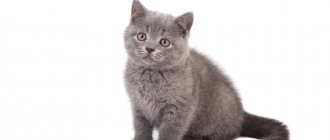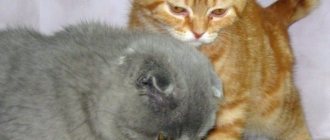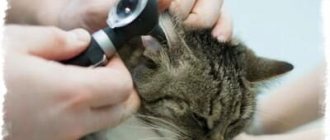One glance at this creature is enough to send a sweet shiver of awe through you. This shows respect for the forces of nature, and the caracal is a very strong animal. For us it is exotic, for the Turks it is a “black ear”, for the Kazakhs it is a “black brush”. For the world of zoology, this is Lynx Caracal, but simply - the steppe lynx or croak. If this miracle looks amazing in nature, imagine how it will look at home! So, a caracal cat at home: who is she, and how to live side by side with her.
History of the origin of the breed
global $ads_google; //data-ad-slot=”2475549904″ $ads_google = empty($ads_google) ? false : true; ?> if ($ads_google == false) {?>
$ads_google = true; ?> } ?>
The animal is rare, it is on the verge of extinction in its habitat. But the distribution area is still large. The caracal cat lives in the savannas and deserts of Africa, and is also considered its homeland in Asia Minor and Central Asia, the Arabian Peninsula. Seals are also found on the coast of the Caspian Sea.
In nature there are nine subspecies of this wild breed. They differ in size and color. African animals are the most numerous, but the Turkmen species has long been in the Red Book, recognized as endangered.
It so happened that a previously wild animal became a domestic animal, and moreover, an exclusive pet. But we are not talking about wild steppe cats, but about domestic caracals raised in nurseries.
What kind of animal is this - caracal
The name of the cat is literally translated from Turkish as “black ears”. The animal is otherwise called “steppe lynx”. This breed appeared recently - in the 18th century, but even now these animals are considered rare and are in danger of extinction. Several years ago, cats turned into exclusive pets - it is possible that thanks to this it will be possible to maintain their population.
The caracal becomes domesticated so that its population can be maintained
The caracal is classified as a mammalian carnivore of the cat family. In appearance, the animal is similar to a lynx, so until recently it belonged to this population, but was later separated into a separate genus. As for morphological characteristics, in this case the caracal can be compared with a puma or an African serval, with which, by the way, the animal mates well at home. The caracal is listed in the International Red Book (second category) as an endangered animal.
Description and standards of caracal
Above we said that there are 9 subspecies of caracal, although a person far from botany or felinology is unlikely to notice the difference from photographs.
Any steppe lynx is very large and tall. You can’t call her massive: her natural grace cannot be hidden, her heaviness does not catch the eye.
The elongated head is crowned with elongated narrow ears with the most charming tassels at the tips. There is a decent distance between the ears and they stand strictly vertical. On the back of the ears the skin is either flat black or gray.
The body looks lean and short. The tail is shorter than half the body. The graceful caracal moves on high, lean limbs. The paws are massive and large.
The color of the coat is beautiful, reminiscent of ocher mixed with sand. The villi are short and reddish. The fur on the belly and chest is longer. Yellow stripes under the eyes. There are no differences in color between males and females.
Dimensions and weight of caracals
The tall caracal cat reaches half a meter at the withers in adulthood. Pretty solid! The weight of cats reaches 15-21 kg. The weight of females is less than that of males. If such a pet sits on his lap, the owner will immediately feel every kilogram of the handsome man.
Caracal hybrids
Several breeders in Russia, Ukraine and the USA have bred and continue to breed caracal-domestic cat hybrids. Moreover, in the USA the Abyssinian cat is used.
global $ads_google; //data-ad-slot=”2475549904″ $ads_google = empty($ads_google) ? false : true; ?> if ($ads_google == false) {?>
$ads_google = true; ?> } ?>
The experimental breed was named caracat (cara(cal)+cat), which indicates its origin. The first generation hybrid is the most difficult to breed, because the male caracal does not accept representatives of another species for the purpose of reproduction. But breeders are persistent; today there are cats in the world that look like caracals, with an affectionate character and smaller dimensions.
For some reason, dogs don’t perceive Carket as a cat. For them, this is a creature equivalent to them, and relationships are built on the dog-dog principle
Another hybrid is the servical, or ser-caracal. In this case, breeders took a male from a serval and a female from a caracal. The cat's appearance resembles a serval, and its ears come from Caracal blood. This is a completely new breed, a pure experiment.
Appearance
The caracal attracts attention with its combination of strength and grace. With a height at the withers of about half a meter, the weight of the animal reaches 20 kg. The long legs make its silhouette almost square, with the hind legs being slightly longer than the front ones. The tail looks shortened (half the length of the body), but not stubby. The coat is thick, short, rough, especially on the hind legs, slightly longer on the lower part of the body, with developed undercoat.
The color ranges from sand to brown, turning on the belly into a much lighter tone with numerous small spots, which helps the caracal to remain invisible against the backdrop of scorched sand. Males are no different in color from cats, but a little more massive. The shape of the head is rounded, slightly elongated, like a lynx, but the ears are noticeably longer, and not only due to the tassels - their length can be 5 cm. As already mentioned, the ears of a caracal are most often the color of “salt and pepper”, and those of caracals from Namibia - pure white, but the tassels are always jet black. The characteristic black “paths” give the muzzle a sad expression.
Characteristics of the caracal
The character of a caracal cat is determined by its upbringing. Even a domestic one obtained from a nursery is still a predator. And the character of predators cannot be touching by nature.
Education allows you to smooth out the rough edges and make the home life of the caracal and people pleasant and interesting.
Cats do not have mood swings; they do not go from anger to excessive tenderness. They are characterized by curiosity and energy. The caracal kitten loves to play, so you will have to train it from the very beginning. If this is not done, then the natural power of the growing cat will become destructive for the house and its inhabitants.
The main thing to remember is that you cannot play with your hands with cats. Use various accessories for entertainment
The first couple of years of life, kittens are very emotional. This can cause problems if the owner lacks time and understanding. So and so, but you will have to show patience and understanding.
An adult, well-mannered caracal is even-tempered and devoted to its human family. In general, this is an ordinary large cat who is happy to sleep next to his beloved owner.
Raising and training a pet
If there are rodents and birds in the house, then it would be naive to think about friendship between a predator and these innocent creatures.
Raising a kitten begins from the first days of its stay in the apartment. You need to let your child know that he is part of the household order. You can't do it without patience and effort.
Also, small children and the caracal should not be together all the time. The breed has not been studied enough to accurately give an answer about the absolute safety of such a joint stay. Definitely, education comes first!
For the first two years, the kitten is taught to comply with subordination. If everything is done correctly, the cat quickly understands who is boss in the pack. Rough methods in education are not needed. You can decisively take away the thing that the cat took, but this should not have been done. The cat is quite capable of grasping the tone and shades of mood and correctly interpreting it.
Kittens get accustomed to the litter box very quickly, but they do not bury excrement, so the owner will be forced to always monitor the cleanliness of the litter box. The caracal is able to mark territory; it is its most zealous defender. This is also leveled out by proper upbringing.
Care and what to feed at home
It is best to keep a domestic caracal cat in a spacious home. If there is already a cat and a dog in the house, adding a baby with ear tufts will go smoothly.
global $ads_google; //data-ad-slot=”2475549904″ $ads_google = empty($ads_google) ? false : true; ?> if ($ads_google == false) {?>
$ads_google = true; ?> } ?>
Such a large predator is kept in approximately 15 m². So you will have to allocate a whole room for him in the apartment or a large enclosure next to the house.
A scratching post will definitely help, because often cutting the claws of a twenty-kilogram stubborn cat is a dubious pleasure.
It is better to have your nails trimmed by a veterinarian. Considering the cat's weight and mood, this will be the best solution.
The steppe lynx takes care of its coat and sometimes doesn’t even mind taking a bath. It is necessary to teach bathing from childhood. They lick their fur often; it is better to help the cat with this procedure once a week and use a furminator.
Ears and eyes are cleaned as needed with clean, damp cloths.
Feeding must necessarily include meat and fish. The domestic caracal is fed separately from other pets 1-2 times a day. The amount of food is calculated based on the age and size of the cat.
The diet must contain vitamins and minerals. The difficulty is that the kitty is indifferent to ready-made food, so let’s return to the predator’s menu: rodents, poultry, boiled meat. A cat should eat 300-800 g of food per day.
Animal health
The health of domestic lynx is usually excellent. Vaccination helps protect your cat from a number of possible cat diseases. The first vaccination is given at 10-12 weeks, and all others strictly according to the schedule suggested by the veterinarian.
Once a year, they are vaccinated against feline panleukopenia, rhinotracheitis and calcevirosis, and antiparasitic treatment is carried out.
There is a separate issue of castration. If the owner is not a professional breeder, he will be advised to neuter the caracal at 9 months. This will protect the family from aggressive splashes and unpleasant odors.
Breeding can be done all year round. During this time, the female can have three offspring with the birth of 1-6 babies at a time. The female and male get used to each other within 2 weeks. Pregnancy is long - 78-81 days.
The breed may develop Aujesz's disease, pseudorabies. To prevent such a disease, pork is not added to the diet.
How long do domestic caracals live?
When purchasing such an exotic pet, you want it to please you with its presence for as long as possible. The question of how long Caracal cats live is relevant for owners.
The lifespan of a caracal is 15-20 years.
, if the owner takes care of them as expected.
Reproduction
The female caracal is committed to polygamous relationships: mating can occur with several males. After conception, the male leaves for his territory, and the cat, for 2.5 months, prepares several secluded places for future offspring. Pregnancy lasts up to 80 days.
The baby caracal, usually two, sometimes up to four, stays with its mother for up to a month after lambing and travels with her to survive among other predators, feeding only on milk.
From the age of 1 month to six months, the kitten moves independently and gets accustomed to solid food. With the onset of six months of age, the animal is considered adult and leaves the female.
If there is no desire for offspring, it is better to sterilize the cat at the age of 9 months, as this animal can show aggression and be unpredictable.
Price and where to buy a caracal kitten
The demand for domestic caracal is very high. There are many people who are willing to part with a large sum of money for the sake of a coveted extravagant pet in their home. Including the upcoming costs of transportation and maintenance, the amount turns out to be quite substantial.
global $ads_google; //data-ad-slot=”2475549904″ $ads_google = empty($ads_google) ? false : true; ?> if ($ads_google == false) {?>
$ads_google = true; ?> } ?>
First, a nursery is selected: you need to inquire about official documents. Nursery owners always issue all documents for the animal, and also provide various consultations on the care and training of the caracal.
Due to the natural characteristics of the breed, a cat should be purchased at the age of 4-5 months. Before purchasing, visit the nursery and study the conditions of keeping the animals, the nuances of feeding and walking. If the nursery is home, then this is an advantage: the kitten is kept next to a person from childhood, it will be easier for him to survive relocation to a new home.
The kittens are examined, examining the fur, the cleanliness of the eyes and ears. There should be no discharge. You can watch the cat spend its time and find out its reaction to people.
The price of a caracal kitten is 400,000-450,000 rubles
, Kotofeya is bought abroad for
6,000-8,000 dollars
. Cats are more expensive in price than cats. This cost is due to the fact that the animals are not so easy to raise and breed.
How to name kittens
Naming a young caracal is not easy. You certainly can’t call him Vasya. You can ask about the names of the area where the cat’s ancestors come from. Maybe this will give the new owner an original idea. The name of an animal cannot be very complex and dissonant. This is a representative of the feline species, which means that hissing names will still be welcome.
The domestic caracal should be named exotically, but in a way that emphasizes its nature and beauty.
We offer a list of names for boys and girls; you can choose a ready-made nickname. Nickname table
| Girl | Boy | ||
| Sparkle Unit Alani Lucien Daisy Hannah Gata Mystery Aurora Fanta | Eva Laina Zlata Lika Marta Pamela Larry Isa Gerda Zvezda | Red Martyn Aman Shaitan Mirage Markus Luntik Felix Remmy Adis | Lapsus Kiryan Almaz Harison Cupcake Uncas Milan Velez Archie Richie |
Conclusions about the breed
Grace, strength, beauty. Wild ancestors passed on to the domestic caracal cat all the best that nature gave them. Good health, powerful strong paws, beautiful fur the color of ocher and reddish sand. One can say different things about the animal, whose ancestors came from the steppes, savannah and semi-desert. But we will emphasize the main thing:
- Excellent immunity;
- The ability to build relationships with a person on their terms thanks to upbringing;
- Demanding requirements for a “carnivorous” diet;
- Playfulness, energy - spending time with such a pet is very interesting;
- To keep it, you need to fulfill a number of conditions; if a person is not ready for this, you should not get a cat yet;
- Difficulties in relationships with children and small rodents and birds. If everything is settled with children by upbringing, then it is very difficult for a cat not to eat a bird.
Is it worth buying a pet caracal? This is a very serious responsibility, if you are ready for it, then somewhere a small cat with tufts on his ears is waiting!
Nuances of education
Caracals get used to the house very easily. An animal taken from a nursery at the age of 3-4 months is already socialized. When properly raised, the caracal does not show aggression; it is very curious, active, affectionate and friendly .
For those who have dealt with puppies, raising a caracal will not be difficult. The animal requires a strict, but fair and affectionate attitude. You cannot shout at your pet, and physical punishment is unacceptable. However, unwanted behavior must be stopped immediately. Even at a very early age, a kitten should not climb onto the dining table, try food from plates and pots, or chew wires and shoes. Remove all valuable and fragile items, as well as anything that could be dangerous for your pet: cords, plastic bags, household chemicals, poisonous houseplants.
The pet easily gets used to walking on a harness. Caracals should be walked away from dog parks. A predator should not be allowed to roam without a leash outside a closed enclosure.
Breeders do not recommend keeping caracals for people who have children under 5 years of age. Older people should explain the rules of communication with a pet.
Owners who do not plan to breed should consider sterilization . A sexually mature caracal of either sex actively marks its territory and can become aggressive and unpredictable.











